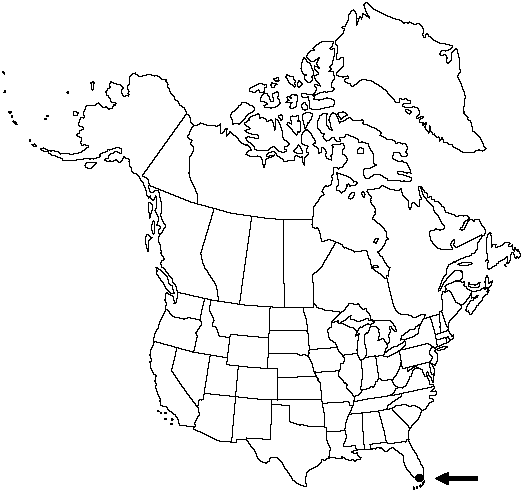Difference between revisions of "Asplenium ×biscayneanum"
Fern Bull. 12: 45. 1904.
FNA>Volume Importer |
imported>Volume Importer |
||
| (7 intermediate revisions by 2 users not shown) | |||
| Line 8: | Line 8: | ||
}} | }} | ||
|common_names=Biscayne spleenwort | |common_names=Biscayne spleenwort | ||
| − | |basionyms={{Treatment/ID/ | + | |basionyms={{Treatment/ID/Basionym |
|name=Asplenium rhizophyllum var. biscayneanum | |name=Asplenium rhizophyllum var. biscayneanum | ||
|authority=D. C. Eaton | |authority=D. C. Eaton | ||
| + | |rank=variety | ||
| + | |publication_title=Bull. Torrey Bot. Club | ||
| + | |publication_place=14: 97, plate 168. 1887 | ||
}} | }} | ||
|synonyms= | |synonyms= | ||
| Line 20: | Line 23: | ||
}}<!-- | }}<!-- | ||
| − | --><span class="statement" id="st- | + | --><span class="statement" id="st-undefined" data-properties=""><b>Roots </b>proliferous. <b>Stems</b> erect, not branched; scales blackish throughout, linear-deltate, sparse, 1–1.3 × 0.1–2.4 mm, margins entire. <b>Leaves</b> nearly monomorphic. <b>Petiole</b> green, becoming blackish in older leaves, 1–5(–12) cm, 1/8–1/3 length of blade; indument of black, narrowly lanceolate scales. <b>Blade</b> dull, linear, 2-pinnate, (4–)12–22 × 1–3.5 cm, papery, glabrous; base slightly tapered; apex narrowing gradually, not rooting. <b>Rachis</b> mostly blackish, green distally and in juvenile leaves, shiny, sparsely scaly. <b>Pinnae</b> in 9–20 pairs, oblong, 0.5–2 × 0.4–1.3 cm; apex blunt to truncate. <b>Pinnules</b> of 1–2 segments; segments linear-oblong, 3–6 × 1–3 mm; margins dentate; apex notched, pointed, rounded, or blunt. <b>Veins</b> free, evident. <b>Sori</b> 1–2 per segment, on both basiscopic and acroscopic sides. <b>Spores</b> abortive. <b>2n</b> = ca. 180.</span><!-- |
-->{{Treatment/Body | -->{{Treatment/Body | ||
| Line 26: | Line 29: | ||
|elevation=0–20 m | |elevation=0–20 m | ||
|distribution=Fla. | |distribution=Fla. | ||
| − | |discussion=<p>Asplenium × biscayneanum is the hybrid of A. trichomanes-dentatum and A. verecundum, with which it occurs. This peculiar spleenwort may most readily be separated from A. trichomanes-dentatum by its deeply cut pinnae, and from A. verecundum by being only 2-pinnate and having long petioles. Chromosome pairing in A. × biscayneanum is irregular. Judging from herbarium collections, it shows considerable hybrid vigor. All the collections are from Dade County, Florida, where it may now be extirpated.</p> | + | |discussion=<p><i>Asplenium</i> × <i>biscayneanum</i> is the hybrid of <i>A. trichomanes-dentatum</i> and <i>A. verecundum</i>, with which it occurs. This peculiar spleenwort may most readily be separated from <i>A. trichomanes-dentatum</i> by its deeply cut pinnae, and from <i>A. verecundum</i> by being only 2-pinnate and having long petioles. Chromosome pairing in <i>A.</i> × <i>biscayneanum</i> is irregular. Judging from herbarium collections, it shows considerable hybrid vigor. All the collections are from Dade County, Florida, where it may now be extirpated.</p> |
|tables= | |tables= | ||
|references= | |references= | ||
| Line 35: | Line 38: | ||
-->{{#Taxon: | -->{{#Taxon: | ||
name=Asplenium ×biscayneanum | name=Asplenium ×biscayneanum | ||
| − | |||
|authority=(D. C. Eaton) A. A. Eaton | |authority=(D. C. Eaton) A. A. Eaton | ||
|rank=species | |rank=species | ||
| Line 49: | Line 51: | ||
|publication year=1904 | |publication year=1904 | ||
|special status= | |special status= | ||
| − | |source xml=https:// | + | |source xml=https://bitbucket.org/aafc-mbb/fna-data-curation/src/2e0870ddd59836b60bcf96646a41e87ea5a5943a/coarse_grained_fna_xml/V2/V2_120.xml |
|genus=Asplenium | |genus=Asplenium | ||
|species=Asplenium ×biscayneanum | |species=Asplenium ×biscayneanum | ||
| − | |||
| − | |||
| − | |||
| − | |||
| − | |||
| − | |||
| − | |||
| − | |||
| − | |||
| − | |||
| − | |||
| − | |||
| − | |||
| − | |||
| − | |||
| − | |||
| − | |||
| − | |||
| − | |||
| − | |||
| − | |||
| − | |||
| − | |||
| − | |||
| − | |||
| − | |||
| − | |||
| − | |||
| − | |||
| − | |||
| − | |||
| − | |||
| − | |||
| − | |||
| − | |||
| − | |||
| − | |||
| − | |||
| − | |||
| − | |||
| − | |||
| − | |||
| − | |||
| − | |||
}}<!-- | }}<!-- | ||
-->[[Category:Treatment]][[Category:Asplenium]] | -->[[Category:Treatment]][[Category:Asplenium]] | ||
Latest revision as of 20:21, 5 November 2020
Roots proliferous. Stems erect, not branched; scales blackish throughout, linear-deltate, sparse, 1–1.3 × 0.1–2.4 mm, margins entire. Leaves nearly monomorphic. Petiole green, becoming blackish in older leaves, 1–5(–12) cm, 1/8–1/3 length of blade; indument of black, narrowly lanceolate scales. Blade dull, linear, 2-pinnate, (4–)12–22 × 1–3.5 cm, papery, glabrous; base slightly tapered; apex narrowing gradually, not rooting. Rachis mostly blackish, green distally and in juvenile leaves, shiny, sparsely scaly. Pinnae in 9–20 pairs, oblong, 0.5–2 × 0.4–1.3 cm; apex blunt to truncate. Pinnules of 1–2 segments; segments linear-oblong, 3–6 × 1–3 mm; margins dentate; apex notched, pointed, rounded, or blunt. Veins free, evident. Sori 1–2 per segment, on both basiscopic and acroscopic sides. Spores abortive. 2n = ca. 180.
Habitat: Hammocks, on limestone rock faces
Elevation: 0–20 m
Discussion
Asplenium × biscayneanum is the hybrid of A. trichomanes-dentatum and A. verecundum, with which it occurs. This peculiar spleenwort may most readily be separated from A. trichomanes-dentatum by its deeply cut pinnae, and from A. verecundum by being only 2-pinnate and having long petioles. Chromosome pairing in A. × biscayneanum is irregular. Judging from herbarium collections, it shows considerable hybrid vigor. All the collections are from Dade County, Florida, where it may now be extirpated.
Selected References
None.
